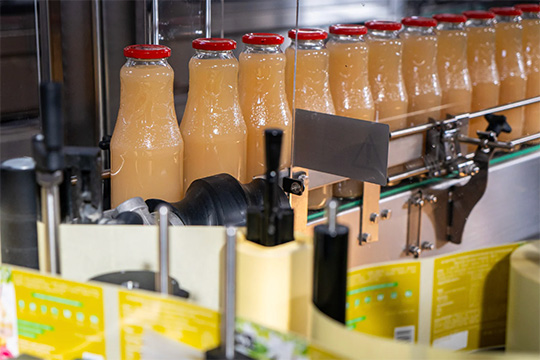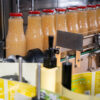In today’s high-throughput production environments, manufacturers increasingly face a dilemma: maintain line speed and throughput while reliably printing dense, multi-line or 2D codes (such as QR codes or DataMatrix symbols) on primary and secondary packaging. Conventional continuous inkjet (CIJ) technology often hits physical and operational limits when tasked with such codes, forcing speed reductions, rework or pre-printing alternatives. This article examines why CIJ systems typically experience speed penalties in dense-code applications and then outlines how continuous thermal inkjet (CTIJ) architectures overcome those constraints — allowing full line speed with high-density codes.
Why Dense Codes Are Different
A dense or multi-line code (for example, a QR code with embedded batch/lot data, or multiple lines of alphanumeric text) is inherently more demanding than a simple one-line alphanumeric mark. The challenges stem from increased pixel density (smaller, closer dots), stricter tolerance for dot placement and contrast, and more rigorous verification requirements. According to the GS1 2D Barcode Verification Process Implementation Guideline, verification of 2D codes includes ensuring quiet zones, dot modulation and edge definition meet specific criteria.¹ Moreover, technical sources identify that “2D codes are more challenging to verify and exhibit higher failure rates” compared with 1D codes. Because each tiny cell in a 2D symbol must be accurately formed, placed and cured, any deviation caused by line speed, substrate movement or ink behaviour can lead to unreadable prints or reduced verification grade.
Root Causes of CIJ Speed Penalties
Below are the primary technical and operational reasons why CIJ systems often cannot maintain full line speed when printing dense, multi-line or 2D codes.
1. Drop-frequency and pixel resolution limitations
CIJ printers form characters and images by ejecting a continuous stream of drops that are deflected to create dot-matrix images. To achieve higher spatial resolution (smaller dot size, closer spacing), the jetting system must either fire more frequently or reduce drop size and/or spacing. However, increasing drop frequency or reducing drop size approaches the design limits of many CIJ systems. When the hardware cannot support the required dot rate, effective print speed must be reduced or multiple passes used. Yet that improvement implies that previous generations were constrained by drop control and placement at high speed
2. Drop-placement accuracy under motion and timing variations
When printing at high conveyor speeds, the timing of each ejected drop, its trajectory and the substrate motion must be tightly coordinated. Even minor deviations in timing, substrate vibration, or drop flight path can misplace a dot by a fraction of a millimetre — a tolerable error for simple alphanumeric text but often fatal for dense 2D symbol cells. The result: to maintain placement accuracy, many CIJ systems require the line to slow down, or the print module to print fewer images per second.
3. Ink-substrate interaction, drying, and bleed
Dense codes deposit more ink per unit area. If the ink spreads (bleeds) or does not fix/dry properly before subsequent handling, adjacent cells may merge or contrast may degrade — causing the code to fail verification. With CIJ, high speed plus heavy ink coverage pushes the substrate and ink chemistry to the limit: the drying time may be insufficient, or the ink may not cure fast enough. Consequently, to mitigate the risk of smearing or insufficient contrast, many producers reduce line speed or alter the ink/substrate combination — both of which reduce overall throughput.
4. Printhead and nozzle architecture not optimized for multi-line/dense codes
Many CIJ systems were originally developed for single-line variable content (dates, batch codes) rather than full image or multi-line blocks. Their printhead geometry, drop-trajectory design and nozzle arrangement reflect that use case. When tasked with full multi-line code blocks or 2D symbols, limitations become apparent: fewer nozzle rows, less dense drop patterns, and less precise placement capability.
5. Environmental and duty-cycle variability
CIJ printers operate in continuous mode within a solvent-based system, where factors like ambient temperature, solvent evaporation, meniscus stability and nozzle cleanliness all influence drop formation consistency. Over long production runs at high speed, these variables can shift — leading to inconsistent drop placement or size, which in turn undermines dense-code quality. In practice, many users reduce speed or insert quality checks to accommodate the uncertainty.
Together, these five factors often force CIJ users to reduce line speed, engage in multiple passes, switch to pre-printing of codes, or accept lower verification grades. The hidden cost: reduced throughput, increased complexity, and higher total cost of ownership for the packaging line.
Practical Consequences on The Production Floor
Beyond the technical discussion, the real-world impact is significant. Some common outcomes include:
- Higher reject and re-work rates as dense codes fail verification or decode tests.
- Conveyor slow-downs or additional print-heads added solely to compensate for reduced output.
- Shifting code printing to pre-printed labels or film, thus adding supply-chain steps and reducing flexibility.
- Investment in specialized “high resolution” CIJ models, which still may not match throughput of simpler text printing. Industry sources warn that verifying 2D codes is more challenging and failure risk is elevated, which means many producers build in speed margins or reduce run speeds to maintain quality.² From a business standpoint, the trade-off becomes: Do I sacrifice line speed, supply-chain flexibility or print quality?
How CTIJ Keeps Max Speed with Dense Codes
Continuous Thermal Inkjet (CTIJ) represents an evolution in inkjet printing architecture that addresses many of the limitations described above. The following are the key technical advantages that make CTIJ a strong choice for dense code printing on high-speed lines.
Precise drop formation and stable meniscus
CTIJ uses thermal ejection technology (similar in principle to TIJ) to form drops with very consistent size, velocity and trajectory. Because the meniscus and nozzle behaviour are tightly controlled, drop placement error is significantly reduced. With fewer deviations in drop behaviour, manufacturers can print dense symbols at full line speed without needing to slow the conveyor or reduce coverage.
High native pixel density without sacrificing speed
Because CTIJ combines the drop-precision of thermal inkjet with the continuous-run, bulk-ink architecture of CIJ, it offers higher native drop density (i.e., smaller, more closely spaced drops) while maintaining the uptime and volume advantages of continuous systems. In effect, the printer can deliver the pixel resolution needed for dense codes without reducing throughput or requiring multiple passes.
Improved ink-substrate interaction and reduced drying constraints
CTIJ systems typically offer better control of the chemistry, better drop consistency and often reduced ink volume per dot (because of smaller drops), which reduces bleed and enables faster solidification on challenging substrates. Because the ink delivery is optimized, producers can avoid reducing line speed for drying concerns and still meet verification standards.
Reduced reliance on special head architectures or multi-pass printing
Since CTIJ begins with a resolution level designed for dense codes, users need not switch to specialized CIJ “HR” models or impose slower speeds. This simplifies deployment and reduces the need for dual-head systems or secondary print passes — preserving OEE and lowering system complexity and cost.
Better stability under environmental variation and high duty cycles
Because of its design, CTIJ systems are less sensitive to solvent evaporation, meniscus drift or nozzle cleanliness issues that plague high-duty-cycle CIJ systems under harsh conditions. This stability means fewer unplanned stoppages, fewer adjustments, and more consistent code quality at high speeds.
From an operational and marketing standpoint, the case is clear: when dense, multi-line or 2D codes are required on high-speed lines, CTIJ offers a path to preserve throughput, maintain code quality and reduce total cost of ownership.
Recommendations for Engineers and Production Managers
- Test at full line speed: When moving to dense codes or 2D symbols, verify them under actual line motion, substrate handling and ambient conditions — not just static prints. GS1 guidelines emphasize the need for real-world verification.¹
- Define target verification grade and pixel density upfront: Know your required GS1 grade (for instance Q/H) and ensure your printing system can deliver the requisite dot size, contrast and placement.¹
- Match print technology to code demand: If you are printing simple one-line dates or batch codes, CIJ may suffice. But if you are printing dense 2D codes at full pack rate, CTIJ is an ideal solution.
- Optimize ink, substrate and downstream handling: Even the best printhead will underperform if ink selection, substrate compatibility or curing/transport is overlooked.
- Monitor and maintain printhead performance: High-duty operations demand that drop formation, nozzle alignment and drop placement remain within specifications. Routine maintenance ensures consistent output and avoids built-in speed attrition.
Conclusion
In the packaging and marking landscape where traceability, serialization, consumer engagement and supply-chain visibility are driving adoption of dense, multi-line and 2D codes, manufacturers cannot afford to treat printing as an afterthought. Traditional CIJ technology, while excellent for many variable-content applications, often runs into inherent physical limitations when pressed for high speed plus high pixel density, forcing line slow-downs or increased complexity. By contrast, CTIJ technology offers a compelling alternative: TIJ-level drop control packaged in a continuous-run architecture that enables dense-code printing without sacrificing throughput or quality.
For producers seeking to “control all your coding printers from primary to secondary packaging”, the choice of print technology becomes a strategic decision — one that impacts line speed, compliance, print quality and total cost of ownership.
References
- GS1, 2D Barcode Verification Process Implementation Guideline, July 2015.
- Cognex, “How to Verify 2-D Codes,” accessed on November 13, 2025.





Recent Comments